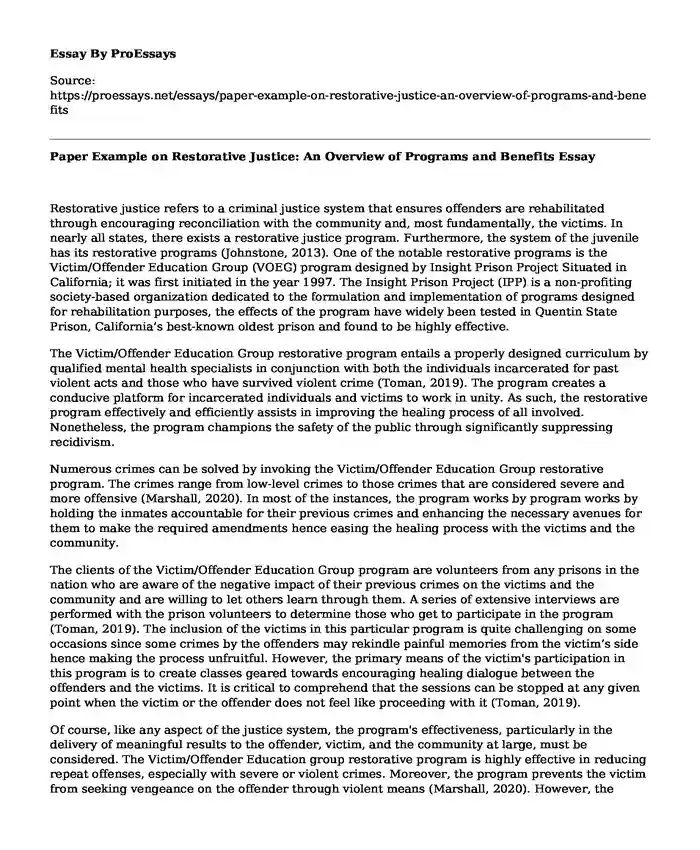Restorative justice refers to a criminal justice system that ensures offenders are rehabilitated through encouraging reconciliation with the community and, most fundamentally, the victims. In nearly all states, there exists a restorative justice program. Furthermore, the system of the juvenile has its restorative programs (Johnstone, 2013). One of the notable restorative programs is the Victim/Offender Education Group (VOEG) program designed by Insight Prison Project Situated in California; it was first initiated in the year 1997. The Insight Prison Project (IPP) is a non-profiting society-based organization dedicated to the formulation and implementation of programs designed for rehabilitation purposes, the effects of the program have widely been tested in Quentin State Prison, California’s best-known oldest prison and found to be highly effective.
The Victim/Offender Education Group restorative program entails a properly designed curriculum by qualified mental health specialists in conjunction with both the individuals incarcerated for past violent acts and those who have survived violent crime (Toman, 2019). The program creates a conducive platform for incarcerated individuals and victims to work in unity. As such, the restorative program effectively and efficiently assists in improving the healing process of all involved. Nonetheless, the program champions the safety of the public through significantly suppressing recidivism.
Numerous crimes can be solved by invoking the Victim/Offender Education Group restorative program. The crimes range from low-level crimes to those crimes that are considered severe and more offensive (Marshall, 2020). In most of the instances, the program works by program works by holding the inmates accountable for their previous crimes and enhancing the necessary avenues for them to make the required amendments hence easing the healing process with the victims and the community.
The clients of the Victim/Offender Education Group program are volunteers from any prisons in the nation who are aware of the negative impact of their previous crimes on the victims and the community and are willing to let others learn through them. A series of extensive interviews are performed with the prison volunteers to determine those who get to participate in the program (Toman, 2019). The inclusion of the victims in this particular program is quite challenging on some occasions since some crimes by the offenders may rekindle painful memories from the victim’s side hence making the process unfruitful. However, the primary means of the victim's participation in this program is to create classes geared towards encouraging healing dialogue between the offenders and the victims. It is critical to comprehend that the sessions can be stopped at any given point when the victim or the offender does not feel like proceeding with it (Toman, 2019).
Of course, like any aspect of the justice system, the program's effectiveness, particularly in the delivery of meaningful results to the offender, victim, and the community at large, must be considered. The Victim/Offender Education group restorative program is highly effective in reducing repeat offenses, especially with severe or violent crimes. Moreover, the program prevents the victim from seeking vengeance on the offender through violent means (Marshall, 2020). However, the program is somehow less effective since not all offenders can obtain the offer. Still, only those who admit their crimes, the efficiency of the program is made even more complicated when the victims fail to accept the offer (Johnstone, 2013).
Conclusion
In conclusion, the restorative justice program is dramatically effective and efficient in solving some crimes. However, the program may fail in cases where the offender's crime is too grievous to be forgiven. An example of such a program is the Victim/Offender Education program, which aims at bridging the gap between the offender, victim, and the community through a series of constructive dialogue sessions.
References
Johnstone, G. (2013). Restorative justice: ideas, values, debates. Routledge.
Marshall, C. D. (2020). Restorative justice. In Religion Matters (pp. 101-117). Springer, Singapore. https://doi.org/10.1007/978-981-15-2489-9_7
Toman, E. L. (2019). The victim-offender overlap behind bars: Linking prison misconduct and victimization. Justice Quarterly, 36(2), 350-382. https://doi.org/10.1080/07418825.2017.1402072
Cite this page
Paper Example on Restorative Justice: An Overview of Programs and Benefits. (2023, Sep 27). Retrieved from https://proessays.net/essays/paper-example-on-restorative-justice-an-overview-of-programs-and-benefits
If you are the original author of this essay and no longer wish to have it published on the ProEssays website, please click below to request its removal:
- Why Children Should be Given Less Homework Essay
- Essay Example on Technological Revolution Transforming Education: Impact on Society
- Essay Example on Matrilineal Societies: Asante Women Left Without Support
- Essay on The Town: Analyzing Crime Through Biological, Strain Theories
- Cultivating Communication: My Experience With a Blunt CEO - Essay Sample
- Stephen's Sex Discrimination Case - Case Study
- My life of Reading - Free Essay Example







